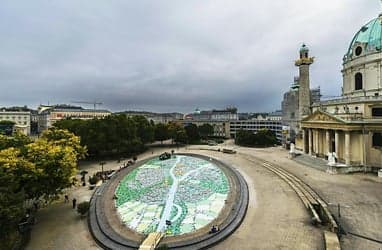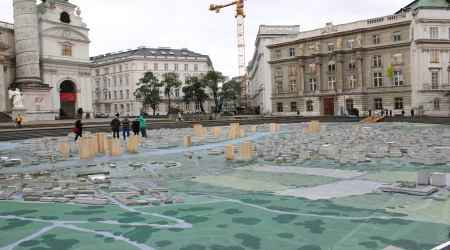Vienna's €19 billion ‘Hypotopia’ city

A group of students has constructed a model city for 102,574 inhabitants in one of Vienna’s main
squares – as a form of protest against the taxpayer-funded bailout of the Hypo Alpe Adria bank for
the sum of €19 billion.
The multidisciplinary team of students from the Technical University of Vienna planned, designed and built the model city over the course of the summer for a 19 day exhibition in October. Its name - Hypotopia - comes from the ill-fated Austrian bank which was expensively nationalised in 2009, Hypo Alpe Adria, and the word utopia. The model city project is intended to show a better way in which the several billions of euros could have been spent. The banking scandal has been the biggest financial disaster to hit Austria since the war, resulting in huge public losses and the imprisonment of former Hypo Alpe Adria CEO, Wolfgang Kulterer. But according to architecture student Diana Contiu, one of the leading figures involved in the project, it was not the scale of the bailout that was so surprising. “Much more shocking is the reaction of the Austrian population,” she said in a recent speech at a TEDx event about the nature of Hypotopia. “Because there was no reaction. Despite a petition they only got 150,000 signatures, which is nothing - in Austria, there are eight million people living here.” This sentiment was echoed by project founder and civil engineering student Lukas Zeilbauer. The pair wanted to mobilise members of the public to engage with the scandal. “The problem is, such a large amount of money is difficult to understand,” he said. “You can’t visualise it. We wanted to provide a better way of helping people to understand the huge waste involved and show them something tangible, show them what Austria could have done with the money instead. So we built a city.” Working within the constraints of a €19 billion budget, they designed Hypotopia to house over 100,000 inhabitants. If the plans were to be put into action, it would make the fictitious metropolis the sixth largest in Austria. Starting in May, Zeilbauer’s team of budding architects, engineers and urban planners - with the approval of Vienna’s Technical University - spent four months meticulously planning out and putting together the city. “Every wooden and concrete block you see in the model is a building,” explained Zeilbauer. “We know how many people live on each floor, what purpose the building is for and how much it costs per square metre. We’ve included everything a city needs. Though, you’ll find there are no banks here in Hypotopia.”  Photo: Pénélope Roussel The volunteers built Hypotopia without any external funding or help. Raw materials - including 30 cubic metres of concrete - were donated by businesses which the team wrote to for help, after explaining the nature of the protest. The students themselves invested over 10,000 hours of work to put the city together and making the exhibition come to life. Since opening on October 15th the Hypotopia exhibition has generated international interest and attracted thousands of visitors - ranging from groups of schoolchildren clambering over the concrete blocks, to political figures including the NEOS party chairman Matthias Strolz. Though as Zeilbauer is quick to point out, most other politicians declined the invitation to take a walk through the model city. Hypotopia is being exhibited in Vienna’s Karlsplatz until the end of October, accompanied by a series of lectures and discussions being held across the square in the Technical University. Zeilbauer hopes that the visualisation of the financial losses incurred will not just educate and inform, but lead directly to tangible change. The group’s website describes the city as “a protest in concrete”. By Ajit Niranjan
Photo: Pénélope Roussel The volunteers built Hypotopia without any external funding or help. Raw materials - including 30 cubic metres of concrete - were donated by businesses which the team wrote to for help, after explaining the nature of the protest. The students themselves invested over 10,000 hours of work to put the city together and making the exhibition come to life. Since opening on October 15th the Hypotopia exhibition has generated international interest and attracted thousands of visitors - ranging from groups of schoolchildren clambering over the concrete blocks, to political figures including the NEOS party chairman Matthias Strolz. Though as Zeilbauer is quick to point out, most other politicians declined the invitation to take a walk through the model city. Hypotopia is being exhibited in Vienna’s Karlsplatz until the end of October, accompanied by a series of lectures and discussions being held across the square in the Technical University. Zeilbauer hopes that the visualisation of the financial losses incurred will not just educate and inform, but lead directly to tangible change. The group’s website describes the city as “a protest in concrete”. By Ajit Niranjan
Comments
See Also
The multidisciplinary team of students from the Technical University of Vienna planned, designed and built the model city over the course of the summer for a 19 day exhibition in October.
Its name - Hypotopia - comes from the ill-fated Austrian bank which was expensively nationalised in 2009, Hypo Alpe Adria, and the word utopia.
The model city project is intended to show a better way in which the several billions of euros could have been spent.
The banking scandal has been the biggest financial disaster to hit Austria since the war, resulting in huge public losses and the imprisonment of former Hypo Alpe Adria CEO, Wolfgang Kulterer.
But according to architecture student Diana Contiu, one of the leading figures involved in the project, it was not the scale of the bailout that was so surprising. “Much more shocking is the reaction of the Austrian population,” she said in a recent speech at a TEDx event about the nature of Hypotopia.
“Because there was no reaction. Despite a petition they only got 150,000 signatures, which is nothing - in Austria, there are eight million people living here.”
This sentiment was echoed by project founder and civil engineering student Lukas Zeilbauer. The pair wanted to mobilise members of the public to engage with the scandal. “The problem is, such a large amount of money is difficult to understand,” he said.
“You can’t visualise it. We wanted to provide a better way of helping people to understand the huge waste involved and show them something tangible, show them what Austria could have done with the money instead. So we built a city.”
Working within the constraints of a €19 billion budget, they designed Hypotopia to house over 100,000 inhabitants. If the plans were to be put into action, it would make the fictitious metropolis the sixth largest in Austria.
Starting in May, Zeilbauer’s team of budding architects, engineers and urban planners - with the approval of Vienna’s Technical University - spent four months meticulously planning out and putting together the city.
“Every wooden and concrete block you see in the model is a building,” explained Zeilbauer. “We know how many people live on each floor, what purpose the building is for and how much it costs per square metre. We’ve included everything a city needs. Though, you’ll find there are no banks here in Hypotopia.”

Photo: Pénélope Roussel
The volunteers built Hypotopia without any external funding or help. Raw materials - including 30 cubic metres of concrete - were donated by businesses which the team wrote to for help, after explaining the nature of the protest. The students themselves invested over 10,000 hours of work to put the city together and making the exhibition come to life.
Since opening on October 15th the Hypotopia exhibition has generated international interest and attracted thousands of visitors - ranging from groups of schoolchildren clambering over the concrete blocks, to political figures including the NEOS party chairman Matthias Strolz.
Though as Zeilbauer is quick to point out, most other politicians declined the invitation to take a walk through the model city.
Hypotopia is being exhibited in Vienna’s Karlsplatz until the end of October, accompanied by a series of lectures and discussions being held across the square in the Technical University.
Zeilbauer hopes that the visualisation of the financial losses incurred will not just educate and inform, but lead directly to tangible change. The group’s website describes the city as “a protest in concrete”.
By Ajit Niranjan
Join the conversation in our comments section below. Share your own views and experience and if you have a question or suggestion for our journalists then email us at [email protected].
Please keep comments civil, constructive and on topic – and make sure to read our terms of use before getting involved.
Please log in here to leave a comment.